Color fills our world with beauty. We delight in the colors of a magnificent sunset and in the bright red and golden-yellow leaves of autumn. We are charmed by gorgeous flowering plants and the brilliantly colored arch of a rainbow. We also use color in various ways to add pleasure and interest to our lives. For example, many people choose the colors of their clothes carefully and decorate their homes with colors that create beautiful, restful, or exciting effects. By their selection and arrangement of colors, artists try to make their paintings more realistic or expressive.
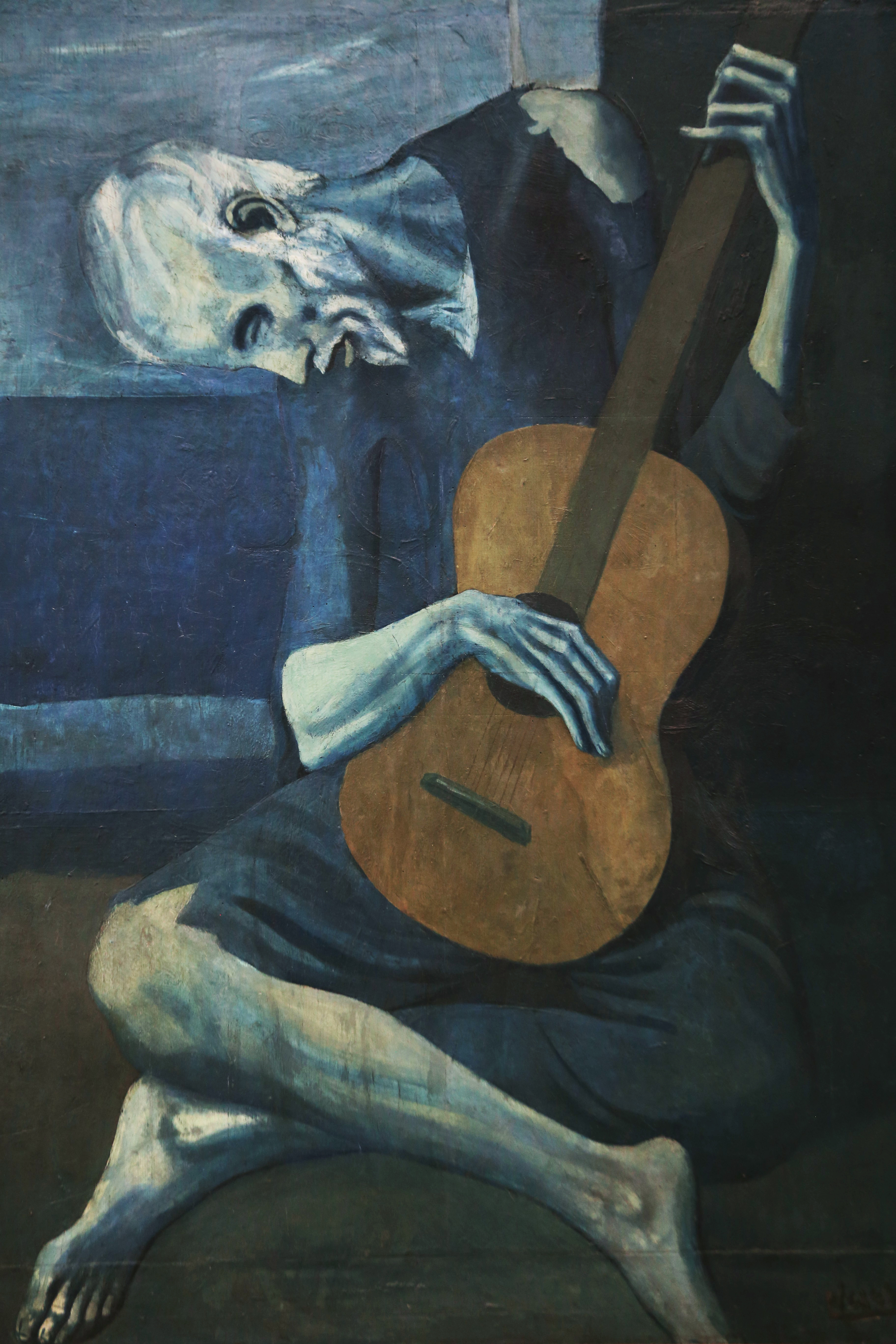
Color serves as a means of communication. In sports, different colored uniforms show which team the players are on. On streets and highways, a red traffic light tells drivers to stop, and a green light tells them to go. On a map printed in color, blue may stand for rivers and other bodies of water, green for forests and parks, and black for highways and other roads.
We use the names of colors in many common expressions to describe moods and feelings. For example, we say a sad person feels blue and a jealous one is green with envy. We say an angry person sees red. A coward may be called yellow.
Color plays an important part in nature. The brilliant colors of many kinds of blossoms attract insects. The insects may pollinate the flowers, causing the plants to develop seeds and fruits. Colorful fruits attract many kinds of fruit-eating animals, which pass the seeds of the fruits in their droppings. The seeds may then sprout wherever the droppings fall. In this way, fruit-bearing plants may be spread naturally to new areas.

The colors of some animals help them attract mates. For example, a peacock spreads his brightly colored feathers when courting a female. The colors of many other animals help them escape from enemies. For example, Arctic hares have brownish fur in summer. In winter, their fur turns white, making it difficult for enemies to see the hares in the snow.

Although we speak of seeing colors or objects, we do not actually see them. Instead, we see the light that objects reflect or give off. Our eyes absorb this light and change it into electrochemical signals. The signals travel through nerves to the brain, which interprets them as colored images. However, there is much that scientists still do not know about how our eyes and brain enable us to sense color.
The relation between color and light
To understand how we see color, we must first know something about the nature of light. Light is a form of energy that behaves in some ways like waves. Light waves have a range of wavelengths. A wavelength is the distance between any point on one wave and the corresponding point on the next wave. Different wavelengths of light appear to us as different colors. Light that contains all wavelengths in the same proportions as sunlight appears white. See Light .
When a beam of sunlight passes through a specially shaped glass object called a prism, the rays of different wavelengths are bent at different angles. The bending breaks up the sunlight into a beautiful band of colors. This band contains all the colors of the rainbow and is called the visible spectrum. At one end of the spectrum, the light appears as violet. It consists of the shortest wavelengths of light that we can see. Farther along the spectrum, the light has increasingly longer wavelengths. It appears as blue, green, yellow, orange, and red, each shading into its neighboring colors in the spectrum. The longest wavelengths of light that we can see appear deep red in color. Some descriptions of the spectrum also mention the color indigo, which is closely related to blue, between violet and blue.
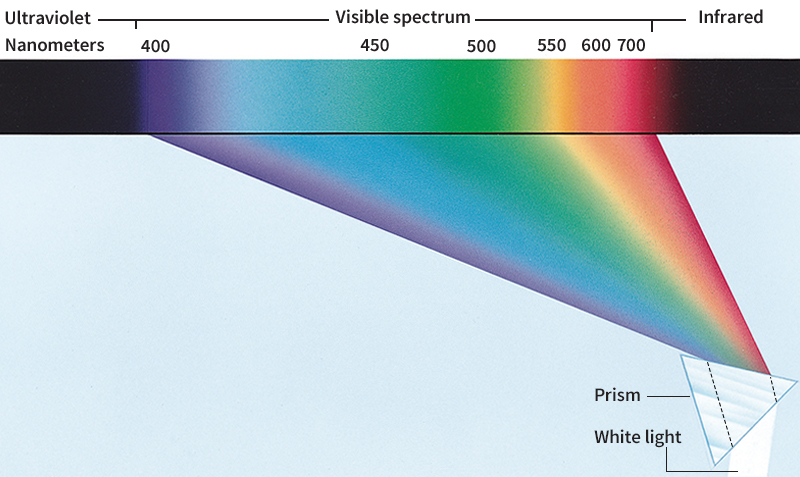
Light waves are a form of electromagnetic waves, which consist of patterns of electric and magnetic energy. The visible spectrum is only a small part of the electromagnetic spectrum—the entire range of electromagnetic waves. Beyond the violet end of the visible spectrum are ultraviolet rays, X rays, and gamma rays. Beyond the red end of the visible spectrum are infrared rays and radio waves. See Electromagnetic waves .
Such objects as traffic lights and neon signs appear colored because the light that they give off contains a limited range of wavelengths. However, most objects appear colored because their chemical structure absorbs certain wavelengths of light and reflects others. When sunlight strikes a carrot, for example, molecules in the carrot absorb most of the light of short wavelengths. Most of the light of longer wavelengths is reflected. When these longer wavelengths of light reach our eyes, the carrot appears orange.
An object that reflects most of the light of all wavelengths in nearly equal amounts appears white. An object that absorbs most of the light of all wavelengths in nearly equal amounts appears black.
How we see color
The roles of the eyes and brain.
Our ability to see color depends on many highly complicated workings of the eyes and brain. When we look at an object, light coming from the object enters our eyes. Each eye focuses the light, forming an image of the object on the retina. The retina is a thin layer of tissue covering the back and sides of the inside of the eyeball. It contains millions of light-sensitive cells. The retina takes in the light and turns it into electrochemical (electrical and chemical) signals. These signals then travel through nerve cells to the brain.
The retina has two main types of light-sensitive cells—-rods and cones. The cells are named for their typical shapes. Rods are extremely sensitive to dim light but cannot distinguish wavelengths. For this reason, we see only tones of gray in a dimly lit room. As the light becomes brighter, the cones begin to respond and the rods cease functioning. The retina of a person with normal color vision has three types of cones. One type responds most strongly to light of short wavelengths, which corresponds to the color blue. Another type reacts chiefly to light of middle wavelengths, or green. The third type is most sensitive to light of long wavelengths, or red.
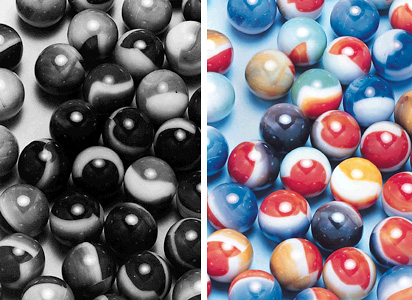
The brain organizes nerve signals from the eye and interprets them as colored visual images. Exactly how the brain makes us aware of colors is still much of a mystery. Scientists have developed several theories to explain color vision. Some of these theories are discussed in the section History of color studies.
Some people do not have full color vision. Such people are often said to be color blind or color deficient. There are different types and degrees of color deficiency, depending on different abnormalities in the retina’s cones. In severe cases, one type of cone may be absent or not functioning. People who have such an abnormality confuse certain colors with others. Few people cannot see colors at all. Most color-vision problems are inherited and cannot be cured. See Color blindness .
Surprising color-vision effects.
Many operations of the eyes and brain work automatically and almost instantly in providing us with color vision. We have learned unconsciously not to “see” certain visual effects of these operations, especially as our eyes adjust to changes of color. When we do become aware of such effects, they may seem dramatic or startling. Some of the color-vision effects that we normally do not notice can be easily demonstrated.
We can demonstrate one color-vision effect by covering half a sheet of brightly colored paper with plain white paper. If we stare at the colored area for about 30 seconds and then remove the white paper, the area that had not been covered will seem much lighter than the half that had been covered. It seems lighter because our eyes adapt to (become accustomed to) colors. Such a visual effect is called chromatic adaptation.
If we stare at a colored image for about 30 seconds and then look at a white surface, we see an afterimage. The afterimage has the same shape as the original image but different colors. Where the original image was red, the afterimage will be green. Where the image was green, the afterimage will be red. Blue areas become yellow, and yellow areas become blue. Black and white also reverse. The technical name for this amazing color-vision effect is successive contrast.
We can also demonstrate that the appearance of a color is influenced by surrounding colors. If we place the same color against different background colors, the color will look different in each case. In addition, a color appears lighter when surrounded by a dark background than when surrounded by a light background. This color-vision effect is called chromatic induction or simultaneous contrast.
Sometimes, we may see colors in areas that are only black and white. Such colors are called phantom colors. Phantom colors may be seen by staring at flashing black-and-white patterns, such as those produced by spinning tops sometimes sold in museum shops.
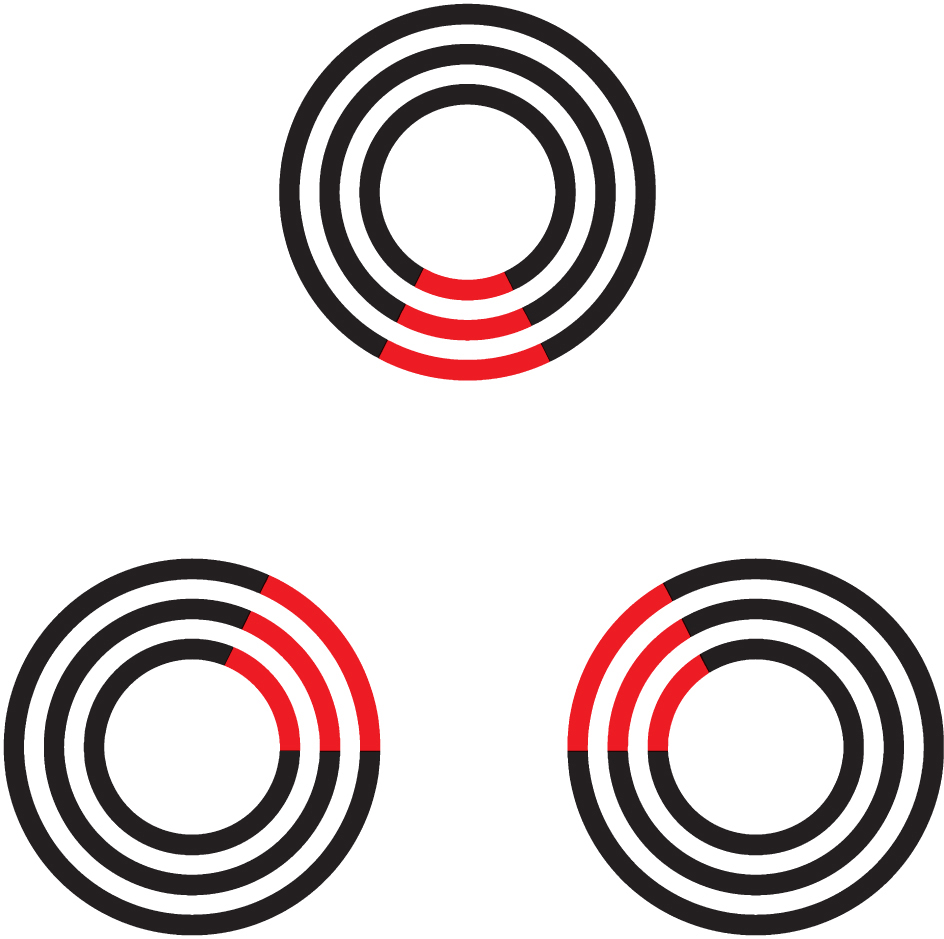
Color vision in animals
Apes, monkeys, many kinds of birds, and some species of fishes have color vision much like ours. However, numerous other animals see colors differently from the way we do. For example, research shows that crocodiles see colors as various shades of gray. The eyes of certain other animals are sensitive to light that we cannot see. For example, bees can see ultraviolet rays, which are invisible to people. On the other hand, bees cannot see the light that we see as red.
Methods of color production
Manufacturers, artists, and craftworkers produce objects in a tremendous variety of colors. To create so many different colors, they use one of two basic methods. These methods are (1) mixing colorants and (2) mixing colored lights.
Mixing colorants.
A great variety of colors can be created by mixing colorants. Colorants are chemical substances that give color to such materials as ink, paint, crayons, and chalk. Most colorants consist of fine powders that are mixed with liquids, wax, or other substances to make them easier to apply to objects. Colorants that dissolve in liquids are called dyes. Colorants that do not dissolve but spread through liquids or other substances as tiny solid particles are called pigments.
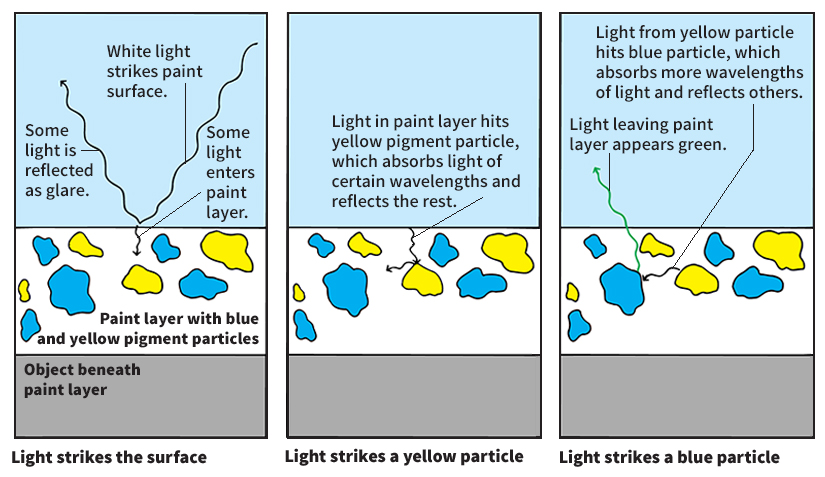
When two different colorants are mixed, a third color is produced. For example, when paint with blue pigment is mixed with paint that has yellow pigment, the resulting paint appears green. When light strikes the surface of this paint, much of it penetrates the paint layer and hits pigment particles. The blue pigment absorbs most of the light of long wavelengths—light that appears red, orange, and yellow. The yellow pigment absorbs most of the light of short wavelengths—light that appears blue and violet. Most of the light of medium wavelengths is not absorbed but reflected through the surface of the paint. When this light reaches our eyes, we see the paint as green. In a colorant mixture, each colorant absorbs, or subtracts, some of the wavelengths of light that strike it. For this reason, colorant mixtures are sometimes referred to as subtractive color mixtures or color by subtraction.
Any three colorants that can be mixed in different combinations to produce nearly any other color are known as primary colorants or primary colors in paint. A common group of primary colorants consists of red, yellow, and blue. When primary colorants are mixed in pairs, the resulting colors are called secondary colorants or secondary colors in paint. Orange is formed by mixing red and yellow, green by mixing yellow and blue, and purple by mixing blue and red. Color experts have found that magenta (purplish-red), yellow, and cyan (blue-green) make a particularly useful set of primary colorants. These three colorants can be mixed to produce an extremely wide range of colors.
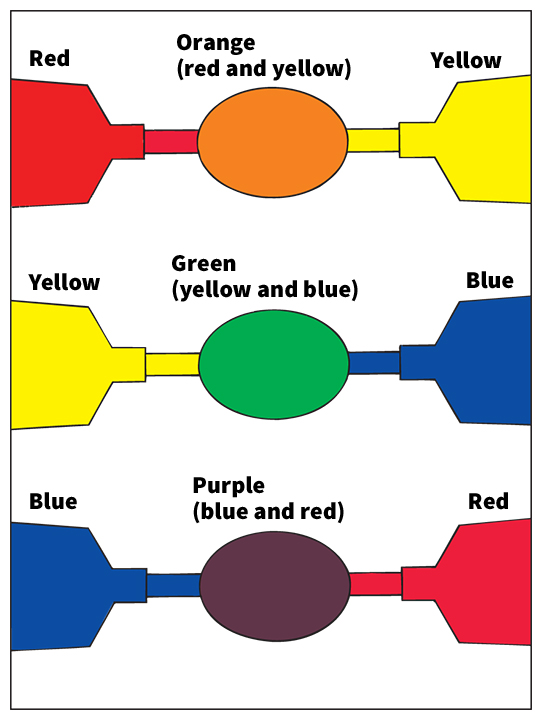
Mixing equal amounts of three primary colorants results in a color that is almost black. However, special black colorants, such as a fine black powder called carbon black, provide better blacks. Mixing black with a color produces a shade. Primary colorants absorb much light, and so they cannot be mixed to produce very light colors. For such purposes, either a chemical compound called titanium dioxide or some other special white colorant must be added. Mixing white with a color produces a tint. The combination of black and white forms gray. Mixing gray with a color creates a tone.
Mixing colored lights.
When lights of different colors are projected together onto a screen, they blend and form new colors. Mixing colored lights produces new colors differently from the way mixing colorants does. Mixing colorants results in new colors because each colorant subtracts some wavelengths of light. But mixing colored lights produces new colors by adding light of different wavelengths. For this reason, colored light mixtures are sometimes called additive color mixtures or color by addition.
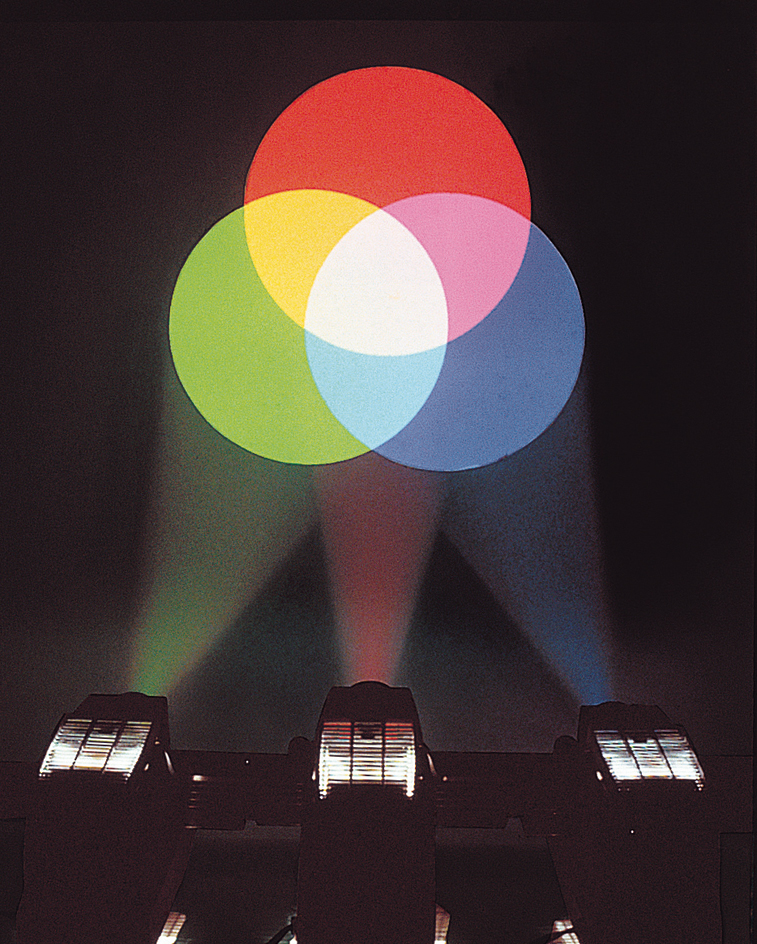
In an additive color mixture, the primary colors differ from those in paint. The primary colors in light are often red, green, and blue. When red and green lights are mixed, the result is yellow light. A mixture of blue and green lights forms blue-green light, and blue and red lights form purple light. Combining all three primary colors in light in the proper proportions results in white light.
The colors of any two lights are complementary if they form white light when mixed. Therefore, the complementary color of any primary color in light is the color formed by combining the two other primary colors. The complement of blue is yellow (red light plus green light). The complement of red is blue-green (blue light plus green light). The complement of green is purple (red light plus blue light).
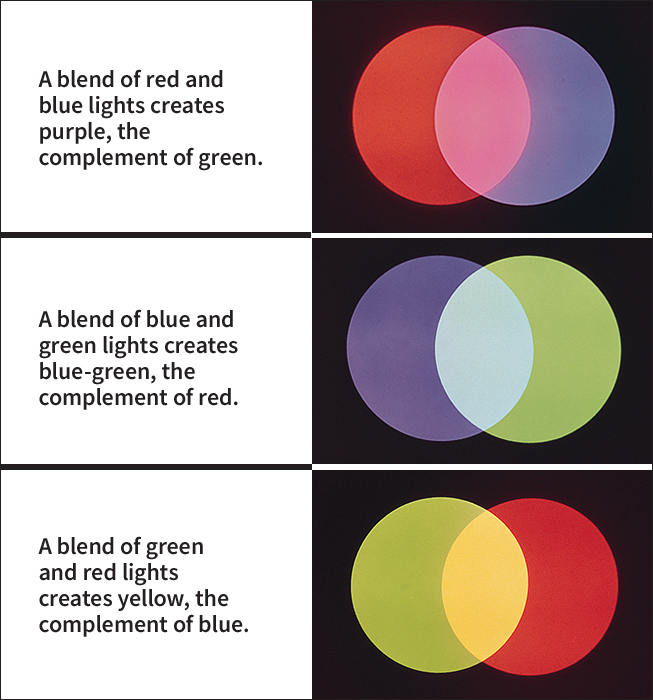
Color television pictures are created by additive mixtures of the three primary colors in light. A color TV screen has thousands of tiny illuminated areas. Some areas produce red light, others produce green light, and still others produce blue light. When we watch a color program, we do not see each red, green, or blue area. Instead, we see a range of many colors produced when the red, green, and blue lights blend in our vision. We see white light when certain amounts of red, green, and blue light are combined. The combining of the primary colors to produce white light makes it possible for a color TV to show black-and-white pictures. See Television (How television works) .
Producing color harmony
When neighboring colors have a pleasing effect, we say that they produce color harmony. In selecting clothes or decorating homes, many people consider what colors look good together. Artists and scientists have developed guidelines for combining colors. But there are no fixed rules of color harmony because too many factors affect whether colors go well together.
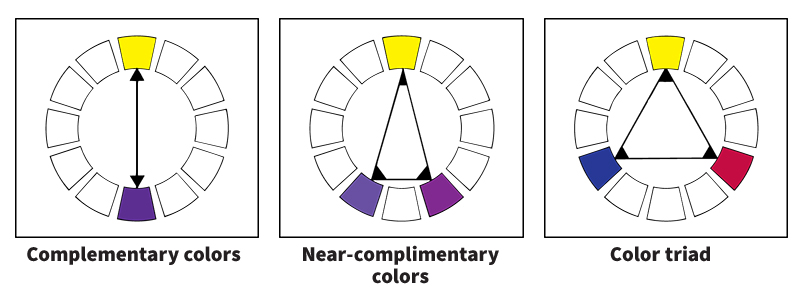
A color circle, or color wheel, shows the relations among colors. It is a helpful tool for choosing harmonious color combinations. A color circle consists of a range of colors in the form of a circle. The colors run from red, through the other colors of the spectrum, and back to red again. Three colors an equal distance apart on the color circle are called a color triad. The colors in a triad often go well together. The primary colors on the color circle—red, yellow, and blue—form a triad. The secondary colors-—green, orange, and purple—are mixtures of two primary colors. They lie at equal distances from the primary colors and also form a triad. Intermediate colors are mixtures of a primary and a secondary color. They lie between primary and secondary colors. A mixture of two secondary colors forms a tertiary color.
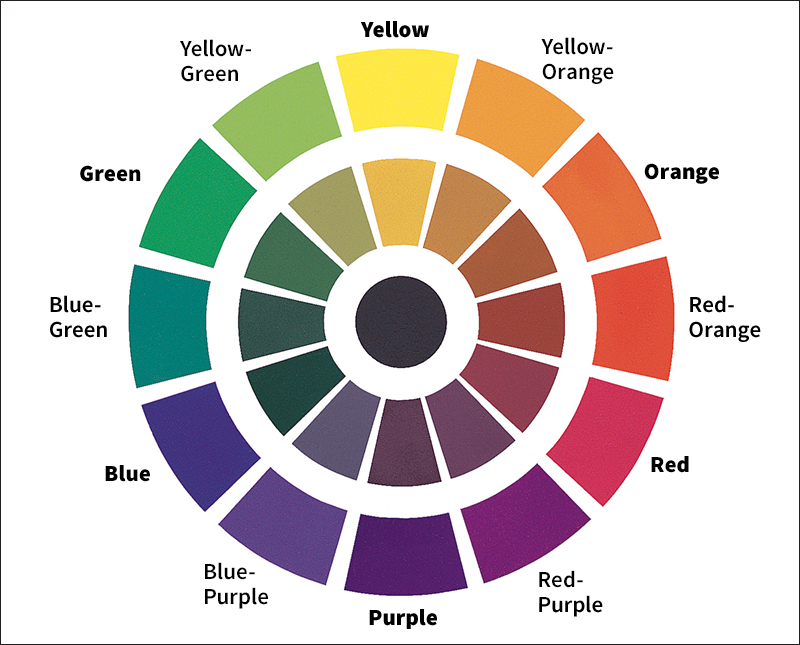
Any two colors that lie directly opposite each other on the color circle are called complementary colors in paint. Such pairs of complementary colors include red and green, orange and blue, and yellow and violet. Complementary colors often go well together. A color also may harmonize with colors that lie next to its complement, such as red with blue-green or yellow-green. Such colors are called near-complementary colors or split complementary colors. Colors that lie next to each other on the color circle, such as blue-green, blue, and blue-violet, also may form pleasing combinations. Monochromatic color schemes are made up of shades, tones, and tints of a single color. Such color combinations can create pleasant effects. For more information on producing color harmony, see Interior design (Color and light) (Using color) .
Characteristics of color
Every color has three basic characteristics. They are (1) hue, (2) lightness, and (3) chroma. Color experts describe an object’s color in terms of these characteristics.
Hue
is the property that gives a color its name—for example, red, orange, yellow, green, blue, or violet or a combination of such names. The dramatic differences that we see among the colors in the spectrum are produced by slight differences in the wavelengths of light. For example, the wavelengths that appear as yellow are only slightly shorter than those that appear as orange. But there is a great visual difference between orange and yellow. This difference is a difference in hue.
Lightness
is our perception of the amount of light reflected from a colored object. The lightness of a color may be expressed by comparing the color’s level of reflected light with that of samples on a lightness scale. A lightness scale runs from black, through shades of gray, to white. Black reflects little light. A color that reflects about the same amount of light as black has a very low lightness level. Gray reflects more light than black. Thus, a color that reflects about the same amount of light as a shade of gray may have an intermediate level of lightness. White reflects nearly all the light that strikes it. Therefore, a color that reflects about the same amount of light as white has a very high lightness level. Color experts use the term brightness to describe the perceived amount of light given off by a colored light source or present in an illuminated environment.
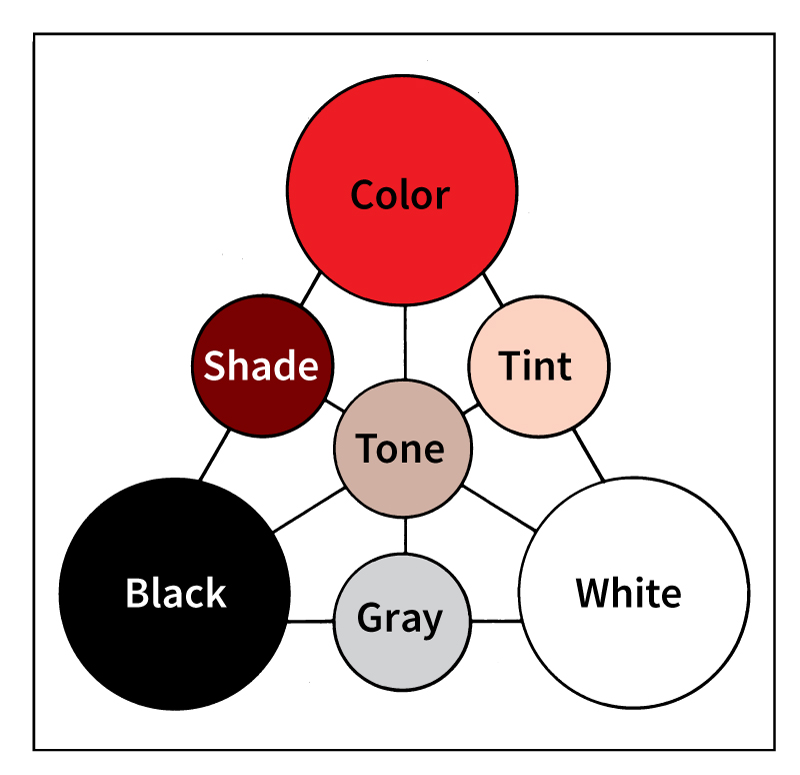
Chroma
is our perception of how much a color differs from gray. It is related to the saturation (concentration) of a color. For example, a teaspoon of red poster paint powder mixed with a teaspoon of water produces paint of a deep red color. The paint has a high concentration of red colorant, and so it has a high chroma. If we dilute the paint with a cup of water, the resulting mixture will appear grayer, having a low concentration of red colorant and, therefore, a low chroma.
How colors are classified
Experts estimate that we can distinguish perhaps as many as 10 million colors. Each color differs from all others in some degree of hue, lightness, or chroma. Our names for colors are far too inexact to describe accurately all the colors we see. As a result, people often have difficulty trying to describe or match a certain color. Matching colors is especially important in such industries as paint and textile manufacturing. Manufacturers of paints and textiles must minimize differences in the color of a particular paint or fabric from one batch of paint or bolt of fabric to another.
To overcome problems in describing and matching colors, color experts have developed various systems of classifying colors. Two widely used classification systems are (1) the Munsell Color System and (2) the CIE System of Color Specification.
The Munsell Color System
is one of the most popular and useful means of classifying colors. It was developed in the early 1900’s by Albert H. Munsell, an American portrait painter and teacher. The system classifies colors according to the three basic characteristics of hue, lightness, and chroma. However, Munsell used the term value for lightness.
The Munsell system may be displayed in many ways. A common display shows samples of different colors arranged around a vertical axis. Different hues are arranged around the axis like the spokes of a wheel, with each spoke consisting of a different hue. The axis serves as the value, or lightness, scale. It is divided into 10 sections. These sections correspond to 10 levels of value from black at the bottom, through shades of gray, to white at the top. All color samples at the same level have the same value. Colors close to the axis have low chroma. The farther from the axis a color is located, the higher is its chroma.
To match a particular color using the Munsell system or a similar system, one must find that color among the color samples provided. However, the number of samples in such systems cannot approach the number of colors we are able to distinguish. For this reason, it is sometimes impossible to find an exact color match.
The CIE System of Color Specification.
Manufacturers of such products as foods, paints, paper, plastics, and textiles must often match colors precisely. Because color vision varies among people, two colors that match for one person may not match for another. For this reason, manufacturers do not rely on the human eye to match colors precisely. Instead, they use the CIE System of Color Specification. CIE stands for Commission Internationale de l’Eclairage (International Commission on Illumination), an international organization that establishes standards for measuring color.
A paint manufacturer who wants to produce the same color of green paint at two factories may use the CIE system to make sure that the two greens match. First, color experts analyze the color of the green paint made at one factory to determine the wavelengths of light that it reflects. They make the analysis with a spectrophotometer. This instrument separates the light reflected from the paint into its various wavelengths and measures their intensity (strength). Then, tables of numbers are used to convert this information into three numerical values—one for each of three primary colors in light, which will match the original green when mixed. These tables of numbers, called standard observers, define the average color-matching properties of a human eye having normal color vision.
The paint made at the second factory is also analyzed using a spectrophotometer. Small amounts of pigment are then added to adjust the color of the paint. Pigment is added until the analysis results in the same three primary color values that were produced by the paint made at the first factory. When these three primary color values are reached, the two green paints will match, even though they may contain different mixtures of pigments.
History of color studies
Early theories of color vision.
Many thinkers in ancient times developed theories about the nature of color. Since then, scientific experiments have confirmed some of their ideas and disproved others.
Empedocles, a Greek philosopher of the 400’s B.C., believed that color vision was caused by tiny particles that were given off by objects and passed through the eyes. He thought that the eyes either produced a color reaction to the particles or recognized them as colored. In the early 300’s B.C., the Greek philosopher Plato proposed that color vision was caused by rays that shot out from the eyes toward objects. Aristotle, a Greek philosopher of the later 300’s B.C., may have been the first person to realize that there is a relation between color and light. However, he also thought that color was caused by something transparent between objects and the eyes. Galen, a Greek physician of the A.D. 100’s, believed that color vision arose because rays from the eyes empowered the surrounding air to carry tiny images of objects to the eyes. He thought that these images then were analyzed by a visual spirit which moved between the eyes and the brain.
During the early 1000’s, an Arab physicist, Ibn al-Haytham, also known as Alhazen, recognized that vision is caused by the reflection of light from objects into our eyes. He stated that this reflected light forms optical images in the eyes. Alhazen believed that the colors we see in objects depend on the light striking the objects and on some property of the objects themselves.
Newton and Goethe.
During the late 1600’s and early 1700’s, Sir Isaac Newton, an English scientist, performed many experiments to investigate the nature of color. Using a prism, Newton demonstrated that white light contains all the colors of the rainbow. He also was the first person to show that colored lights can be combined to form white light. Newton realized that light rays themselves are not colored but that the perception of color is produced in the brain.
During the late 1700’s and early 1800’s, Johann Wolfgang von Goethe, a German poet, experimented with colored lights and shadows. He wrote a book on optics that seemed to contradict many of Newton’s findings. Goethe did not believe that colored lights could be combined to form white light. He thought that all colored lights were actually mixtures of light and darkness. Goethe’s experiments were useful in demonstrating many aspects of color vision. However, Goethe’s theories of color vision based on these experiments are no longer accepted by scientists.
The three-component theory
of color vision was proposed in 1801 by Thomas Young, an English physicist. It was further developed during the 1850’s by a German physicist, Hermann von Helmholtz. The three-component theory is also known as the Young-Helmholtz theory or the trichromatic theory. The theory proposes that the eye has three types of fibers that are sensitive to different wavelengths of light. When light strikes the fibers, they generate electrical signals that travel directly to the brain. According to the three-component theory, the color sensations that arise in the brain correspond to the electrical signals in a simple and direct way. Scientific experiments have confirmed the existence of the three types of fibers, which are now called cones. Each type of cone is particularly sensitive to one of three general ranges of wavelengths of light—those corresponding to red, green, and blue.
The opponent color theory
was proposed in 1874 by Ewald Hering, a German physiologist. Hering suggested that, somewhere in the nerves of the eyes and brain, there are two response mechanisms, each of which involves a pair of opposing colors. This means that the response mechanisms can signal only one of the two colors at a time. One response mechanism signals either red or green, and the other signals either yellow or blue. A third mechanism signals the level of lightness. The brain interprets these signals, producing our sense of color. The opponent color theory explains many aspects of color vision better than the three-component theory does. For example, the opponent color theory provides an explanation for the fact that we see no such colors as reddish-green or yellowish-blue.
Recent theories
combine ideas from the three-component and opponent color theories to describe the various stages of color vision. In the first stage of color vision, three types of cones in the retina absorb light and generate electrical signals, as proposed by the three-component theory. During the second stage of color vision, nerves in the eyes and brain create three new signals, which correspond to those described by the opponent color theory. The nerve signals may pass through further stages before the brain finally interprets them as the sensation of color.
